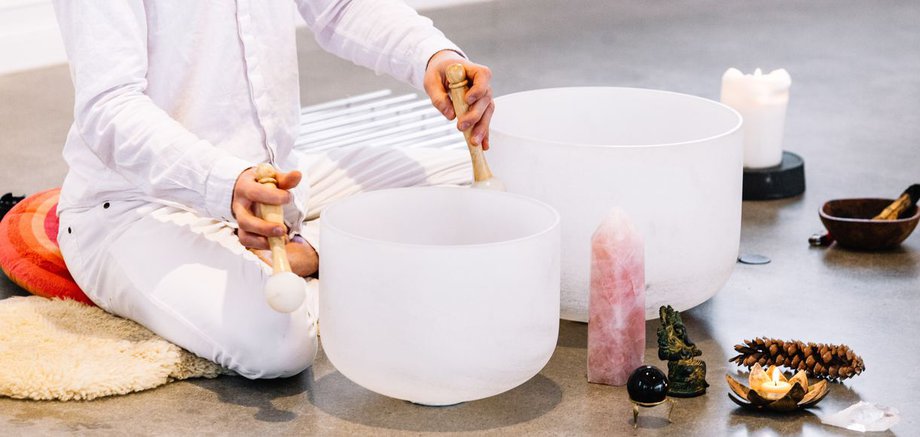Step-by-Step Guide to Sound Bath Meditation Practice

Are you looking to bring more relaxation and mindfulness into your life? Look no further than the step-by-step guide to sound bath meditation practice.
This article will show you how to harness the power of sound to create a soothing and rejuvenating experience. Discover the benefits of sound bath meditation, find the perfect music, prepare your space, set intentions, and deepen your practice.
With these techniques, you can easily integrate sound bath meditation into your daily routine.
Key Takeaways
- Find a quiet and comfortable space
- Choose your preferred sound bath meditation recording
- Set your intention for the meditation session
- Close your eyes and focus on the sounds
The Benefits of Sound Bath Meditation
One of the benefits of sound bath meditation is that it can help reduce stress and anxiety. During a sound bath meditation, you are immersed in healing frequencies produced by various instruments such as crystal bowls, gongs, and chimes. These frequencies have a calming effect on your mind and body, allowing you to enter a state of deep relaxation.
As the sound waves wash over you, they help release tension and melt away the stress that has built up throughout the day. The soothing sounds create a sense of tranquility and promote a feeling of inner peace. Sound bath meditation is a powerful tool for stress reduction, providing a much-needed escape from the demands of daily life and allowing you to find balance and harmony within yourself.
Finding the Right Sound Bath Meditation Music
When it comes to finding the right sound bath meditation music, there are a few tips to keep in mind.
First, consider your personal preferences in terms of genres and sounds that resonate with you.
Next, pay attention to the effects that different types of music have on your mind and body during the meditation session.
Music Selection Tips
To enhance your sound bath meditation experience, start by selecting music that resonates with your personal preferences and promotes a sense of relaxation. The music you choose plays a vital role in creating the right atmosphere for your meditation practice.
Consider opting for instrumental tracks with soothing melodies and gentle rhythms. Look for music that incorporates relaxing sounds such as nature sounds, chimes, or singing bowls. These sounds can help induce a state of deep relaxation and tranquility. Experiment with different genres like ambient, classical, or new age to find what resonates with you the most.
Additionally, incorporating relaxation techniques such as deep breathing and progressive muscle relaxation can further enhance your meditation experience. So take your time, explore different options, and find the perfect music that will guide you on your sound bath meditation journey.
Personal Preferences and Effects
Finding music that resonates with your personal preferences can greatly impact the effectiveness of your meditation experience. When it comes to meditation, everyone has different tastes and preferences when it comes to music.
Here are three important things to consider when selecting music for your meditation practice:
- Genre: Choose a genre that you enjoy and find calming. Whether it’s classical, ambient, or nature sounds, find a genre that helps you relax and enter a meditative state.
- Tempo: Pay attention to the tempo of the music. A slower tempo can help you slow down your breathing and relax your mind, while a faster tempo may energize and uplift you.
- Instrumentation: Consider the instruments used in the music. Some people find that certain instruments like flutes or Tibetan singing bowls have a soothing effect, while others prefer the simplicity of just a piano or guitar.
Preparing Your Space for a Sound Bath Meditation
Create a peaceful and calming atmosphere in your space by dimming the lights and lighting some scented candles. These simple steps can help you create a peaceful ambiance for your sound bath meditation practice.
The soft glow of the candles and the gentle flickering of the flame can instantly set a tranquil mood. Consider choosing candles with scents like lavender or chamomile, known for their calming properties.
Along with the candles, you can also enhance your space by selecting the right props. Place comfortable cushions or pillows on the floor to create a cozy seating area. You can also add blankets or throws for extra comfort.
The goal is to create a space that feels inviting and relaxing, allowing you to fully immerse yourself in the sound bath experience.
Setting Intentions for Your Sound Bath Meditation Practice
Take a moment to reflect on what you hope to gain from your sound bath meditation session. Setting intentions is a powerful way to focus your mind and create a clear path towards your goals.
As you prepare for your practice, consider these manifestation techniques to enhance your experience:
- Visualize: Close your eyes and imagine yourself already embodying your desired outcome. See it, feel it, and believe it to be true.
- Affirmations: Repeat positive affirmations that align with your intentions. Use words that resonate with you and evoke feelings of empowerment and abundance.
- Gratitude: Express gratitude for what you already have and for the manifestation of your intentions. This will cultivate a sense of abundance and attract more positive experiences into your life.
Techniques for Deepening Your Sound Bath Meditation Experience
To enhance your experience during a sound bath meditation, try incorporating these techniques to deepen your practice.
Deepening concentration is essential for a more profound and immersive experience. Start by finding a comfortable position, allowing your body to relax and your mind to let go of any distractions. Focus your attention on the sounds and vibrations surrounding you, letting them guide you into a state of deep concentration.
As you listen, try to tune in to the different layers and frequencies of the sounds, allowing them to envelop your entire being.
Additionally, enhancing relaxation is crucial for a more fulfilling experience. Let go of any tension or stress, allowing the soothing sounds to wash over you and melt away any worries or anxieties. Relax your body, surrendering to the healing vibrations and allowing them to carry you into a state of deep relaxation.
Integrating Sound Bath Meditation Into Your Daily Routine
Are you interested in incorporating sound bath meditation into your daily routine?
Daily practice offers numerous benefits, such as increased relaxation, reduced stress, and improved mental clarity.
If you’re worried about time constraints, don’t fret – we’ll explore strategies for overcoming them, so you can easily fit sound bath meditation into your busy schedule.
Additionally, we’ll discuss how to incorporate different techniques to keep your practice fresh and engaging.
Benefits of Daily Practice
You’ll experience a range of benefits from daily sound bath meditation practice. Here are three key benefits that you can expect to enjoy:
- Reduced stress and anxiety: Through the soothing vibrations and sounds of the sound bath, your body and mind will naturally relax, helping to alleviate stress and anxiety that you may be experiencing. This can lead to a greater sense of calm and overall well-being in your daily life.
- Improved sleep: Sound bath meditation has been shown in scientific research to promote better sleep. The gentle sounds can help to quiet the mind and release tension in the body, allowing you to drift into a restful sleep more easily and wake up feeling refreshed.
- Enhanced creativity and focus: Regular sound bath meditation can enhance your ability to tap into your creative flow and improve focus. The vibrations and frequencies can stimulate the brain and promote a state of deep relaxation, leading to increased clarity, creativity, and productivity in your daily activities.
Overcoming Time Constraints
Now that you understand the benefits of daily sound bath meditation practice, let’s address a common concern: overcoming time constraints. We all lead busy lives, juggling work, family, and various responsibilities. However, it’s essential to prioritize self-care, including sound bath meditation, for your overall well-being.
To help you manage your time effectively, here are some tips:
| Time Management Tips | Prioritizing Self-Care |
|---|---|
| Set a schedule and stick to it | Make self-care non-negotiable |
| Identify time-wasting activities | Delegate or eliminate tasks |
| Break tasks into smaller, manageable chunks | Set boundaries and say no when necessary |
| Utilize time-saving techniques | Practice self-compassion and self-forgiveness |
Incorporating Different Techniques
To incorporate different techniques into your routine, try exploring various forms of meditation such as mindfulness, visualization, or breathwork. By experimenting with different techniques, you can find what works best for you and enhance your meditation practice.
Here are three options to consider:
- Mindfulness: This technique involves focusing your attention on the present moment, observing your thoughts and sensations without judgment. It can help improve your awareness and reduce stress.
- Visualization: This technique uses the power of your imagination to create mental images that promote relaxation and positive emotions. It can be helpful for manifesting your goals or releasing negative energy.
- Breathwork: This technique involves controlling your breathing patterns to promote relaxation and reduce anxiety. Techniques like deep breathing or alternate nostril breathing can help calm your mind and enhance your focus during meditation.
Frequently Asked Questions
How Long Should a Sound Bath Meditation Session Typically Last?
A sound bath meditation session typically lasts for around 30-60 minutes. However, longer sessions can provide even more benefits. They allow you to delve deeper into relaxation and experience a greater sense of calm and rejuvenation.
Can I Practice Sound Bath Meditation if I Have No Experience With Meditation or Mindfulness?
Yes, beginners can practice sound bath meditation even if they have no experience with meditation or mindfulness. To prepare as a beginner, find a quiet space, lie down, and allow the soothing sounds to guide your relaxation.
Are There Any Specific Instruments or Tools That Are Commonly Used in Sound Bath Meditation?
Yes, there are specific instruments and tools commonly used in sound bath meditation. They include singing bowls, gongs, drums, and tuning forks. These instruments enhance the benefits and effectiveness of the practice.
Can Sound Bath Meditation Help With Physical Pain or Ailments?
Sound bath meditation can help with physical pain or ailments. It acts as a form of pain management and offers benefits for chronic conditions. The soothing sounds and vibrations promote relaxation and healing.
Is It Necessary to Have a Designated Meditation Space for Sound Bath Meditation, or Can It Be Done Anywhere?
You don’t need a designated meditation space for sound bath meditation; it can be done anywhere. However, creating a peaceful meditation space at home can enhance the benefits of sound bath meditation.








